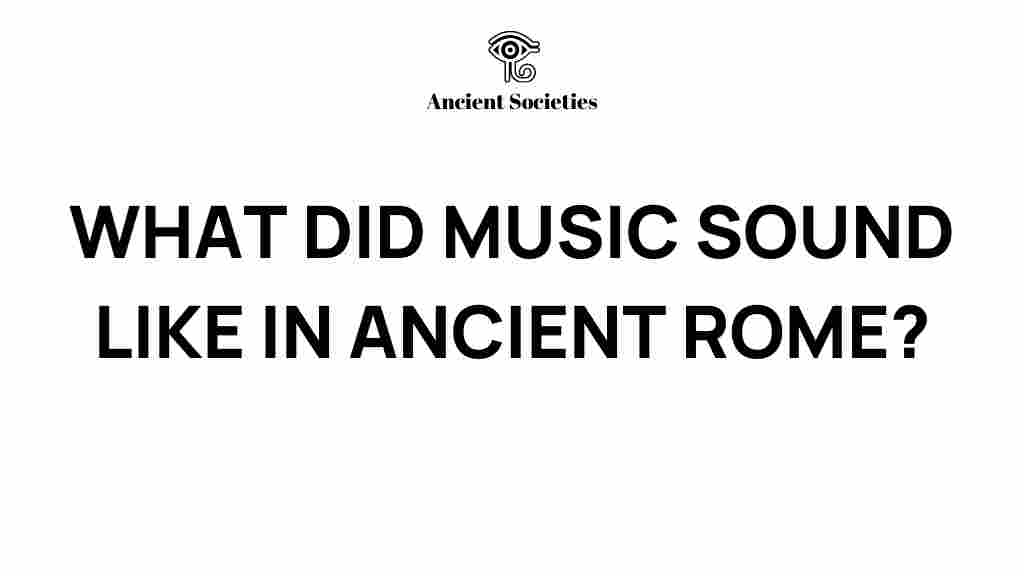Unearthing the Melodies: What Did Music Sound Like in Ancient Rome?
Music has always been an integral part of human civilization, serving as a bridge between cultures and eras. In ancient Rome, music played a vital role in various aspects of daily life, from religious ceremonies to public entertainment. Understanding the music history of ancient Rome not only enriches our appreciation of Roman culture but also sheds light on the broader context of ancient civilizations. This article will delve into the sounds of ancient Rome, exploring the instruments, genres, and cultural significance of music during this fascinating period.
The Role of Music in Roman Society
Music in ancient Rome was not merely a form of entertainment; it was interwoven with various facets of society. Here are some of the key roles that music played:
- Religious Rituals: Music was essential in religious ceremonies, where hymns and chants invoked the favor of the gods.
- Public Entertainment: Music accompanied theatrical performances and gladiatorial games, enhancing the overall experience for the audience.
- Social Gatherings: Music was a staple at banquets and celebrations, bringing people together and fostering community spirit.
- Education: Music education was valued, with many Romans learning to play instruments and sing as part of their upbringing.
The importance of music in these contexts highlights its role as a cultural artifact, providing insights into the social and political life of ancient Rome.
Instruments of Ancient Rome
The musical instruments used in ancient Rome were diverse and reflected a rich tradition influenced by various cultures, including Greek, Etruscan, and even Eastern civilizations. Here are some notable instruments:
- Aulos: A double-reeded woodwind instrument, similar to the modern oboe, used in various settings from festivals to military events.
- Lyre: A string instrument that was commonly used for both solo performances and accompaniment in various genres.
- Tibia: A type of flute made from wood, which was popular in both private and public performances.
- Harp: An ancient string instrument that was often associated with the aristocracy and used in more formal settings.
- Drums: Various types of percussion instruments were used to keep rhythm during celebrations and processions.
These instruments played a crucial role in shaping the historical sounds of ancient Rome, and archaeological findings have provided evidence of their construction and use.
Genres and Styles of Music
Music in ancient Rome was not monolithic; it featured a variety of genres and styles that evolved over time. Some key genres included:
- Choral Music: Often performed in religious contexts, choral music involved groups singing hymns and praises to the gods.
- Instrumental Music: Instrumental performances were common at banquets and public events, where musicians would entertain guests.
- Theatrical Music: Music accompanied plays and performances, enhancing the dramatic effect and engaging the audience.
- Military Music: Fanfare and marching tunes were essential for boosting morale and coordinating movements during military campaigns.
Each genre contributed to the vibrant tapestry of Roman culture, reflecting the society’s values, beliefs, and practices.
Archaeological Insights into Roman Music
Archaeology has played a pivotal role in uncovering the musical heritage of ancient Rome. Excavations of sites such as Pompeii and Herculaneum have revealed numerous artifacts related to music, including:
- Musical Instruments: Well-preserved instruments such as lyres and flutes have been found, offering insights into their design and use.
- Art and Frescoes: Ancient artworks often depict musicians and scenes of musical performance, illustrating the significance of music in daily life.
- Written Records: Texts from Roman authors, such as Cicero and Seneca, reference music, providing context for its cultural importance.
These archaeological findings provide a tangible connection to the past, allowing us to reconstruct the soundscape of ancient Rome and appreciate its cultural heritage.
Reconstructing the Sounds of Ancient Rome
While we may never fully capture the exact sounds of ancient Roman music, modern scholars and musicians have made significant strides in reconstructing these historical sounds. Here’s how:
- Historical Research: Scholars study ancient texts and artifacts to understand the context and styles of music.
- Instrument Recreation: Crafting replicas of ancient instruments allows musicians to experiment with the sounds they produced.
- Performative Interpretation: Musicians adapt ancient notations and practices to create performances that evoke the spirit of ancient Rome.
These efforts not only preserve the legacy of ancient music but also inspire contemporary artists to draw from the rich well of classical music traditions.
Challenges in Understanding Ancient Music
Despite our advancements in music archaeology, there are challenges in fully understanding ancient Roman music:
- Limited Notation: The absence of comprehensive musical notation makes it difficult to accurately reconstruct melodies and rhythms.
- Cultural Differences: The cultural context of Roman music may differ significantly from modern interpretations, leading to potential misinterpretations.
- Fragmentary Evidence: Many artifacts are incomplete or damaged, resulting in gaps in our understanding of the music.
Addressing these challenges requires a multidisciplinary approach, combining archaeology, musicology, and historical research.
Conclusion: The Legacy of Music in Ancient Rome
Ancient Rome’s music history is a testament to the civilization’s complexity and cultural richness. The sounds that resonated through its streets, temples, and amphitheaters continue to echo in our understanding of the past. By exploring Roman music, we not only appreciate the artistry of ancient musicians but also gain insight into the values and beliefs that shaped their society.
As we reflect on the musical instruments, genres, and archaeological findings, it becomes evident that music was a vital part of the Roman identity. The ongoing efforts to reconstruct these historical sounds allow us to keep the legacy of ancient Rome alive, bridging the gap between past and present.
For those interested in delving deeper into this fascinating topic, resources such as musicology articles and archaeological findings can provide additional insights and information.
This article is in the category Culture and created by AncientSocieties Team
